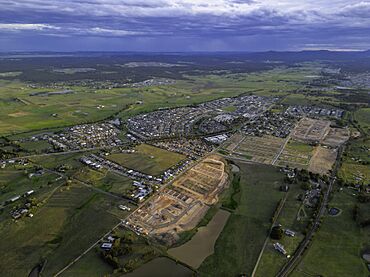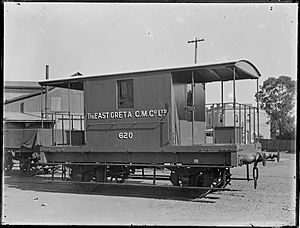Gillieston Heights facts for kids
Quick facts for kids Gillieston HeightsMaitland, New South Wales |
|
|---|---|

Aerial photo of Gillieston Heights.]]
|
|
| Population | 4,796 (2021 census) |
| • Density | 347.5/km2 (900/sq mi) |
| Postcode(s) | 2321 |
| Area | 13.8 km2 (5.3 sq mi) |
| Time zone | AEST (UTC+10) |
| • Summer (DST) | AEDT (UTC+11) |
| Location | |
| LGA(s) | City of Maitland |
| Region | Hunter |
| County | Northumberland |
| Parish | Heddon |
| State electorate(s) | Maitland |
| Federal Division(s) | Hunter |
Gillieston Heights is a suburb in the Hunter Region of New South Wales, Australia. It is part of the City of Maitland local government area. This means it is managed by the Maitland City Council.
The suburb is about 5.1 kilometres (3.2 miles) from the centre of Maitland. Before 1967, it was called East Greta. The name was changed to honour John Gillies. He was a former mayor of Maitland and a member of the state parliament. Residents voted to make this change. In 2021, Gillieston Heights had 4,796 people living there.
Contents
A Look Back: The History of Gillieston Heights
The original owners and caretakers of the land around Maitland are the Wonnarua people. They have lived here for thousands of years.
Coal Mining and Railway Beginnings
In 1888, a person named T.W. Edgeworth David found high-quality coal here. Soon after, a group of business people bought land in the area. Within weeks, they were digging up coal. This coal was taken by horse-drawn carts to Maitland to be sold.
To make the most of this discovery, the East Greta Coal Mining Company started in 1891. This company built a railway line from West Maitland to their coal mine. The railway was finished in 1893. The company started selling coal to power companies in big cities like Sydney, Melbourne, and Bundaberg. By 1896, the company was doing very well. They even opened a second mine shaft that same year.
As coal mining grew, the railway line from Maitland was made longer. In 1902, a train station opened at East Greta. People could now take trains to Stanford Merthyr, near Kurri Kurri. At first, passengers had to walk to Maitland railway station to catch other trains. But in 1903, the service was extended to Maitland. A year later, it went all the way to Cessnock.
End of an Era: Mine Closure and Growth
Mining at the East Greta coal mine stopped after a miners' strike in 1929. Floods in the 1930s also damaged the mine workings. After the mine closed, its buildings and railway tracks were removed. However, the village, with homes built for the miners, remained.
Even after the mine closed, passenger trains continued to serve the town. This private train service between Cessnock and Maitland ended in 1967. But trains carrying coal to other mines in the Cessnock area still used the line.
Since 2005, Gillieston Heights has grown very quickly. Many new homes have been built. This growth is part of the Maitland City Council's plan for urban development. The number of people living here doubled between 2005 and 2011. This rapid growth put pressure on Gillieston Public School. More land was bought for the school to expand in the future.
Who Lives Here? Population Facts
The 2021 census counted 4,796 people living in Gillieston Heights.
- About 7.9% of the people were Aboriginal and Torres Strait Islander people.
- Most people (87.7%) were born in Australia.
- A large majority (90.1%) spoke only English at home.
- When asked about religion, 45.6% said they had no religion. About 20.0% were Catholic, and 16.2% were Anglican.
Getting Around: Transport in Gillieston Heights
Gillieston Heights has a bus service called Rover Coaches route 164. This bus goes to Cessnock and Maitland.
Because the population has grown so much, local councils want to bring back passenger train services. Both the Maitland and Cessnock councils believe this would help with traffic on the roads. A new train station at Gillieston Heights is seen as an important step. This would connect the area to Newcastle.



